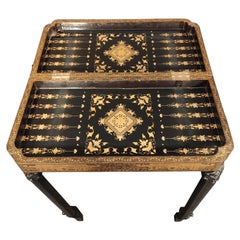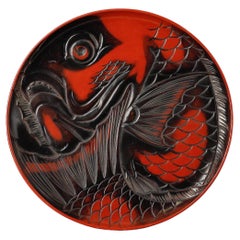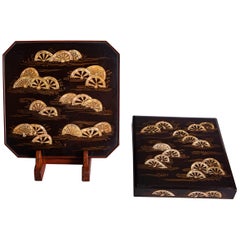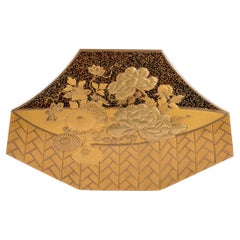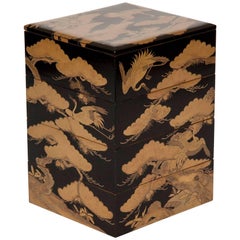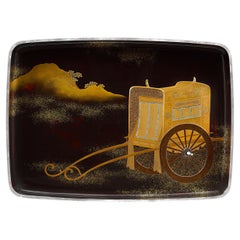East Asian Lacquer
to
40
313
123
483
5
2
4
2
78
264
141
7
78
31
9
7
1
11
6
1
3
3
382
211
103
40
32
557
490
289
196
42
490
486
489
3
1
1
1
1
Place of Origin: East Asian
Chinese Export Lacquered and Mother-of-Pearl Chess Board from 19th with a Table
By Gold China
Located in Madrid, ES
Chinese Export lacquered and mother-of-pearl chess board from 19th with a table carved wood stand.
Size: 58 x 58cm and 73 cm high
Very good condition.
Category
19th Century Chinese Export Antique East Asian Lacquer
Materials
Wood
1937 Japanese Fish Sea Bream Carved Design Wooden Tray
Located in Fukuoka, JP
A Beautiful Japanese Wood Carving Tray with Carp Design.
This beautiful Japanese wood carving tray is a stunning example of Japanese craftsmanship. It is dated 1937 and is in good o...
Category
20th Century Taisho East Asian Lacquer
Materials
Wood, Lacquer
18th Century Japanese Lacquer Writing Box and Tray Set
Located in Hudson, NY
Wheels Submerged in flowing water motif, believed to be a subject popular in samurai families. Example of the same subject matter in Tokyo National Museum.
Category
18th Century Antique East Asian Lacquer
Japanese peony basket lacquered box Edo
Located in PARIS, FR
Eight-sided, flared shaped lacquer kobako box, following the decoration on the lid depicting a basket of flowers, composed of peonies and chrysanthemums in gold takamaki-e and hirama...
Category
18th Century Edo Antique East Asian Lacquer
Materials
Gold
Japanese Black Lacquer Jubako Box with Stork Motif
Located in Stamford, CT
A four-tier Japanese Meiji period black lacquer Jubako box with stork and fir tree decoration. Box in four sections with lid.
Category
Late 19th Century Edo Antique East Asian Lacquer
Materials
Lacquer
Japanese Lacquer Tray
Located in New Orleans, LA
Hailing from illustrious Meiji-period Japan, this lacquer tray showcases the mastery of Japanese craftsmen. Precious materials are precisely inlaid in the lacquer base, creating an a...
Category
Late 19th Century Meiji Antique East Asian Lacquer
Materials
Silver
$19,800
Mid-20th Century Chinese Hand Carved Cinnabar Lacquer Plate
Located in Pomona, CA
This stunning Chinese hand carved cinnabar lacquered plate has Intricate lacquer carving arts of Chinese traditional Floral scene design, an original works of art in the tradition of...
Category
Mid-20th Century Chinese Export East Asian Lacquer
Materials
Lacquer
Japanese Lacquer Tray With Cards
Located in New Orleans, LA
This Meiji-period lacquer tray represents the mastery of Japanese craftsmen in the art of lacquer work. Precious materials are precisely inlaid in the lacquer base, creating a highly...
Category
Late 19th Century Meiji Antique East Asian Lacquer
Materials
Gold
Japanese Lacquered Natsume 'Tea Box'
Located in PARIS, FR
Natsume in dark red lacquer, decorated with autumn leaves and cherry blossoms in hiramaki-e and nashiji. Interior in black lacquer.
Maple leaves (Momiji) are celebrated in literatur...
Category
Mid-20th Century East Asian Lacquer
Materials
Lacquer
Japanese Nagasaki Export Lacquer Box with Depiction of the 'Trippenhuis'
Located in Amsterdam, NL
A Japanese Nagasaki export lacquer box with mother-of-pearl depiction of the Amsterdam ‘Trippenhuis’
Edo-period, circa 1830
H. 12.5 x W. 24...
Category
19th Century Edo Antique East Asian Lacquer
Materials
Mother-of-Pearl, Lacquer
Rhino Contemporary Japanese Lacquer Art by Someya Satoshi
Located in Atlanta, GA
Japanese Lacquer Rhino Sculpture by Someya Satoshi (1983-). A hand-molded lacquer sculpture that depicts a fantasy beast "Rhino". The artist uses century-old traditional techniques and symbols but with an innovative contemporary energy that borders mysticism, shamanism and surrealism. Found objects were equally treated as part of the meticulous designs as the elaborate Maki-e and shell inlays.
According to the press of Honolulu Museum of Art: "Someya Satoshi has been described as “one of the most significant contemporary lacquer artists working in Japan today.” (Japan Times, 12 Dec. 2013) His work combines objects of daily use, such as bathing buckets, serving trays, and soup bowls, with a wide array of natural materials, including animal bones, horns and antlers, sand, stones, leaves and branches. In the process, he implements a range of traditional lacquer methods passed down from pre-modern eras, such as the kanshitsu or “dry lacquer” technique, the origins of which date to Japan’s Nara period (710–784). After creating his forms, he embellishes them with designs inspired by calligraphy, traditional Japanese textile patterns, and even contemporary manga or comic books. His work defies ordinary definitions of lacquer art and successfully challenges the perceived limits of this extremely difficult and, in some ways, most conservative of traditional Japanese art forms".
His work was exhibited in US such as Honolulu Museum of Art, Minneapolis Institute of Art, Morikami Museum etc. For a complete resume of the artist, see the artist's page in Imura Art Gallery.
Reference: For a very similar Bull Sculpture see Hard Bodies Contemporary Japanese Lacquer...
Category
Early 2000s Japonisme East Asian Lacquer
Materials
Rope, Wood, Lacquer
Japanese Lacquer Koro 'Incense Burner'
Located in Hudson, NY
Removable bronze top, with gold drip pattern at top. Cresting ocean waves on bottom with raised silver sea spray.
Category
Early 19th Century Edo Antique East Asian Lacquer
Materials
Silver, Bronze
Japanese Kobako box in the form of a furoshiki present in gold and black lacquer
Located in PARIS, FR
Rectangular and flat lacquer Kobako (small box) representing a furoshiki knot seen from above. Fundame background, furoshiki in takamaki-e with floral pattern, inside the folds of th...
Category
Late 18th Century Edo Antique East Asian Lacquer
Materials
Gold
Early 17th century 'Incense Burner' ( Koro)
Located in Hudson, NY
Early 17th century incense burner( Koro) in basket weave nashiji lacquer pattern with chrysanthemum mons (the national symbol of Japan). Copper grill with detailed waves pattern. Foo...
Category
Early 17th Century Antique East Asian Lacquer
Materials
Copper
19th century Dragon lacquer box
Located in Fukuoka, JP
Large Lacquered hexagonal box on stand depicting Dragon flying amidst the clouds. Unique , appliqués like lacquer technique created amazing effect of almost 3d effect. Multilayered ...
Category
19th Century Edo Antique East Asian Lacquer
Materials
Wood, Lacquer
19th Century Chinese Red Lacquered Melon Vessel with Lift Cover
Located in Brea, CA
19th century Chinese red lacquered papier mâché melon form vessel with lift cover and painted decoration. Measures: H 9 1/2 inch.
Category
Late 19th Century Qing Antique East Asian Lacquer
Materials
Lacquer
Japanese golden kobako flowers Edo period 18th century
Located in PARIS, FR
Quadrangular kobako box decorated with flowers in gold and blue lacquer with aogai inlay. Lid and sides in fundame lacquer, underside and interio...
Category
18th Century Japonisme Antique East Asian Lacquer
Materials
Gold
JAPAN 1900 Meiji Period Fubako Box In Hiramaki-e Lacquered Wood With Gilding
Located in Miami, FL
Fubako letters-box from the Japanese Meiji period (1868-1912).
Beautiful decorative Fubako letters box from the Japanese Imperial Meiji period, circa 1900. This box has been meticul...
Category
Early 1900s Meiji Antique East Asian Lacquer
Materials
Gold
Pair of Antique Japanese Lacquer Trays
Located in Hudson, NY
Pair of antique Japanese Lacquer Trays, Taisho period (1912-1926) beautifully decorated with a miniature landscape of pea pods on the vine and a gold cricket set...
Category
1920s Taisho Vintage East Asian Lacquer
Materials
Lacquer
$2,500 / set
Japanese suzuribako lacquered box peony river
Located in PARIS, FR
Suzuribako box (empty) in black lacquer. Gold maki-e decoration of a river bordered by peonies, one with red highlights. The edges of the lid are in gold lacquer. Nashi-ji interior.
Category
Late 19th Century Antique East Asian Lacquer
Materials
Gold
Japanese Lacquered Furoshiki Kobako 'Box'
Located in PARIS, FR
Rectangular and flat lacquer Kobako (small box) representing a furoshiki knot seen from above. Fundame background, furoshiki in takamaki-e with floral pattern, inside the folds of the fabric with black and gold sayagata pattern with togidashi maki-e technique. The saya (or sayagata) pattern is composed of Chinese swastikas...
Category
Late 19th Century Antique East Asian Lacquer
Materials
Lacquer
Pair of Edo Period Black and Gold Lacquer Samurai Helmet Boxes
Located in Lymington, Hampshire
A pair of Edo period black and gold lacquer Samurai helmet boxes (Hakko Bako), each of ribbed cylindrical form with a lid, a black lacquer interior,...
Category
19th Century Edo Antique East Asian Lacquer
Materials
Lacquer
One Chinese Black Lacquer Rectangular Lidded Jewelry box, Late 19th Century
Located in ARMADALE, VIC
One Chinese Black Lacquer Rectangular Lidded Jewelry box, Late 19th Century
Provenance: Private Melbourne Collection.
Dimensions: Width: 37cm Height: 10.5cm Depth: 20.5cm.
Category
Late 19th Century Qing Antique East Asian Lacquer
Materials
Wood
A Chinese Red Lacquer Lidded Jewelry Box, Early 20th Century
Located in ARMADALE, VIC
A Chinese Red Lacquer Lidded Jewelry Box, Early 20th Century
Provenance: Private Australian Collection.
Dimension: Width: 19cm Height: 22.5cm Depth: 21cm.
Category
Early 20th Century Qing East Asian Lacquer
Materials
Wood
$450 Sale Price
50% Off
Japanese Black Lacquer & Gold Sake, Champagne Flutes or Wine Stemware, Set of 6
Located in New York, NY
A very beautiful set of six (6) Japanese black lacquer and gold sake, Champagne flutes, or wine stemware glasses, circa 20th century, Japan. Each with a different botanical design in...
Category
Early 20th Century East Asian Lacquer
Materials
Wood
Signed Mid 19th C. Edo/Meiji Period Miniature Lacquer Stacking Cabinet, Japan
Located in Oxfordshire, United Kingdom
The highly decorated tray in the form of a table frames a series of three stacking boxes, a further three lidded boxes and a tray concealed within, raised on ogee bracket feet.
This...
Category
19th Century Meiji Antique East Asian Lacquer
Materials
Lacquer
Chinese Black Lacquered Wood Box - Imperial Dragons - Ming Period Wanli 17th
Located in Beuzevillette, FR
Magnificent box Imperial jewelry box in black lacquered wood decorated with dragons.
This wonderful box is lacquered on a black background with patt...
Category
17th Century Ming Antique East Asian Lacquer
Materials
Wood
Japanese Antique Lacquer Natsume (box for matcha powder) Automne Flowers 1980s
Located in Paris, FR
This is a box for the matcha powder using while tea ceremony in Japan.
It is called 'Natsume'. It is made with wood. The design is some automne flowers and it is all hand painted. Th...
Category
1980s Showa Vintage East Asian Lacquer
Materials
Wood, Lacquer
19th Century Red Lacquer Tray with Rabbit Running Over Waves Under Full Moon
Located in Hudson, NY
19th century Japanese red lacquer tray with rabbit running over waves under full moon. Mingei style painting, the imagery of this tray is bas...
Category
Early 19th Century Edo Antique East Asian Lacquer
Materials
Wood, Lacquer
Qing Dynasty Chinese Wooden Red Lacquered Presentation Box
Located in Brea, CA
Qing Dynasty Chinese wooden red lacquered presentation box, lovely and beautiful red lacquer box with popular snacks like roasted melon seeds, dried fruit, this auspicious objects ar...
Category
Mid-19th Century Qing Antique East Asian Lacquer
Materials
Lacquer
Early 17th Century Negoro Lacquer Footed Bowl
Located in Hudson, NY
Early 17th century Negoro lacquer footed bowl, Edo period (1603-1868) round bowl with tripod cabriole style legs. Negoro lacquer (monk's lacquer in red ...
Category
Early 17th Century Edo Antique East Asian Lacquer
Materials
Lacquer
Japanese Antiques Inkstone box with Kasuga Deer Mandala Maki-e by Kan-sai
Located in Niiza, JP
245(W)× 50(H) × 250(D) [mm]
Box size: 280(W)× 100(H) × 300(D) [mm] 1.6kg
A beautiful composition of a mother and child deer is expressed in Taka-maki-e (raised maki-e technique)
Op...
Category
19th Century Antique East Asian Lacquer
Materials
Lacquer
19th Century Large Gilt Lacquer Chinese Tea Caddy
Located in Brea, CA
19th century golden black lacquer Chinese tea caddy with big pewter and a key, the rectangular-section body decorated with panels of landscapes, a very beautiful piece. See more pict...
Category
Early 19th Century Qing Antique East Asian Lacquer
Materials
Lacquer
Japanese Laquered Box with Hinged Lid hand painted, 19th Century Meiji Period
Located in Lincoln, Lincolnshire
This is a good papier mâché, rectangular shaped black lacquered lidded box, hand enamelled and gilded, made in Japan during the 19th century, early Meiji period.
This rectangular shaped papier mâché box has a well fitting hinged lid, with the box base and lid slightly domed. The box was probably originally made as a pocket box but could easily sit on a desk or dressing table as required.
This is a very decorative box with finely hand painted scenes of three people, one holding a parasol, in a garden setting, with a pagoda type building, large gate...
Category
19th Century Meiji Antique East Asian Lacquer
Materials
Paper
Set Antique Chinese Lacquered Wooden Plates
Located in New York, NY
A matched set of Antique Chinese Lacquered Wooden Plates. Sculpted cut Elm wood sections joined together with wooden pins, wire banding and lacquer from the Qing Dynasty. A rare set of Antique Chinese Lacquered Plates...
Category
1880s Qing Antique East Asian Lacquer
Materials
Wood
Fine Lacquer Kogo 'Incense Box'
Located in Hudson, NY
Exquisitely detailed incense storage box in gold lacquer with silver and gold overlays of a folded screen with heron and willow design. Flowers and...
Category
Late 19th Century Meiji Antique East Asian Lacquer
Materials
Lacquer
Japanese, Black Lacquer, Chrysanthemum Shaped Incense Burner 'Koro'
Located in Hudson, NY
With chrysanthemum motif and a gilded bronze lid. Includes unsigned collector's box. Interior measurements: 7 1/2" opening, 5 1/4" deep.
Category
Late 18th Century Antique East Asian Lacquer
Materials
Lacquer
Chinese Gold and Black Lacquer Games Box, Early 19th Century
Located in Bishop's Stortford, Hertfordshire
An exceptional antique Chinese gold and black lacquer games box raised on four paw feet with a domed lift off cover decorated with figural landscape panels in gilded lacquer colours on a black ground. The cover lifts off to reveal five lidded removable counter boxes...
Category
Early 19th Century Antique East Asian Lacquer
Materials
Lacquer
19th Century Chinese Black Lacquer Work Box
Located in Tampa, FL
The 19th century Chinese black lacquer work box has most of the interior with handles on each side. With dragon feet
Category
Late 19th Century Antique East Asian Lacquer
Materials
Wood, Lacquer
Wakasa-Nuri Lacquer Bundai, Ryoshobako, Fubako Set
Located in PARIS, FR
Set of bundai, ryoshibako and fudebako in wakasa lacquer with an old rose background and black traditional Japanese patterns.
The saya pattern (or sayagata) is composed by Chinese svastikas. This symbol linked to Buddhism, mean intelligence, power and peace. It is a good omen sign.
The kanoko pattern reminds stains on fawn back.
The sakura (cherry blossom) pattern is emblematic of Japan. The blossoming in a short time marks spring beginning and is a symbol of renewal and ephemeral beauty.
There are also traces of calligraphy brush, in reference to the function of the objects.
Bundai is a low table used to put books or scrolls and, later, to write.
Rectangular ryoshibako (letter and document box) with a slightly domed
Fudebako (pencil case) of rectangular format very narrow in its length with two rounded corners, flat cover.
Wakasa lacquerware...
Category
Early 20th Century East Asian Lacquer
Materials
Lacquer
18 Pc, Vintage Japanese Lacquerware Rice Bowl Sets 9 Sets Included
Located in Atlanta, GA
This beautiful 18-piece vintage Japanese lacquerware rice bowl set includes nine matching sets, each consisting of a bowl and lid. Each piece is adorned with hand-gilt floral and fol...
Category
20th Century Japonisme East Asian Lacquer
Materials
Lacquer
$476 Sale Price / set
20% Off
Large Early 19th Century Chinoiserie Black Lacquer Box
Located in Richmond, London
A large early 19th century chinoiserie black lacquer and gilt box of a rare shape. Canton, China, circa 1830.
Why we like them
Exquisite gilt decoration, wonderfully preserved orig...
Category
Early 19th Century Chinese Export Antique East Asian Lacquer
Materials
Lacquer
Japanese Antique Lacquer Natsume (box for matcha powder) Red Boat 1980s
Located in Paris, FR
This is a box for the matcha powder using while tea ceremony in Japan.
It is called 'Natsume'. It is made with wood. The design is a boat and it is hand painted. The material is with...
Category
1980s Showa Vintage East Asian Lacquer
Materials
Wood, Lacquer
19th Century Chinoiserie Gilt Painted Box
Located in New York, NY
A 19th century Chinese chinoiserie gilt painted box. Lacquer work box of very high quality.
Beautifully painted.
Category
Early 19th Century Qing Antique East Asian Lacquer
Materials
Wood
Antique Large Scale Japanese Lacquer & Gilt Decorated Tray
Located in Atlanta, GA
This exquisite large-scale antique Japanese lacquer tray showcases masterful gilt decoration against a rich lacquered ground. Its expansi...
Category
19th Century Anglo-Japanese Antique East Asian Lacquer
Materials
Lacquer
$1,036 Sale Price
20% Off
19th Century Chinese Lacquer Box
Located in Brea, CA
19th century Chinese lacquer box from the Qing dynasty. Used as box for nails made of lacquered wood. Oriental scenes in golden. In ve...
Category
19th Century Qing Antique East Asian Lacquer
Materials
Lacquer
Japanese Colonial Nagsaki Lacquer Box with Depiction of Amsterdam, 1830-1840
Located in Amsterdam, NL
An important Japanese lacquer box with a view of The 'Nieuwe Stadsherberg Van Amsterdam
Nagasaki, Edo-period, 1830-1840
The black lacquered wood box, decorated in gold and inla...
Category
Early 19th Century Antique East Asian Lacquer
Materials
Mother-of-Pearl, Wood
Antique Chinese Cloisonne Blue White General Jar Baluster Vase Garniture w Stand
Located in Richmond, CA
This exquisite matching pair of antique Chinese export blue and white cloisonné covered general jars is a fine example of the intricate artistry and craftsmanship of traditional Chin...
Category
Early 20th Century Chinese Export East Asian Lacquer
Materials
Copper, Enamel
17th Century Qing Dynasty Set of 5 Chinese Bamboo Tea Cups with Silver Inlaid
Located in Brea, CA
A fine set of 5pieces Chinese bamboo tea cups with silvered interiors from the 17th century Qing Dynasty, the faces each of each decorated t...
Category
17th Century Qing Antique East Asian Lacquer
Materials
Bamboo
19th Century Chinese Fragment as a Mirror
Located in Tampa, FL
An early 19th century red lacquer with gold accents Chinese fragment with gold courting scenes converted into a mirror. Brass holder for hanging.
Category
Early 19th Century Antique East Asian Lacquer
Materials
Wood, Lacquer
Fine 17th Century Japanese Export Black and Gold Lacquered Pictorial-Style Dish
Located in Amsterdam, NL
A fine Japanese export black and gold lacquered pictorial-style dish Nagasaki or Kyoto, 1680-1720
The dish with wide flat rim of Keaki wood (Zelkova species) in black lacquer with...
Category
17th Century Edo Antique East Asian Lacquer
Materials
Gold
Japanese Antique Lacquer Document Box with Elaborate Hawk and Faux Oak Grain
Located in Hudson, NY
Japanese antique lacquer document box with elaborate hawk and faux oak grain, Late Meiji (1868 - 1912) / Early Taisho (1912 - 1926) period lac...
Category
Early 20th Century East Asian Lacquer
Materials
Lacquer
Japanese Lacquer Tray
Located in New Orleans, LA
As beautiful as it is practical, this Japanese Meiji-period lacquered tray is distinguished by its exceptional craftsmanship. It exhibits a phenomenal artistry as the entire tray is ...
Category
Early 20th Century Meiji East Asian Lacquer
Materials
Lacquer
$8,850
Antique Authentic Chinese Carved Ornate Wood Altar Shrine
Located in Chicago, IL
Antique Authentic Chinese Carved Ornate Wood Altar Shrine
A Chinese altar is perfect for worship or displaying your treasured items. The display space is ...
Category
Early 20th Century Rustic East Asian Lacquer
Materials
Wood, Lacquer
Japanese Antique Lacquer Natsume (box for matcha powder) Plum 'UME' 1980s
Located in Paris, FR
This is a box for the matcha powder using while tea ceremony in Japan.
It is called 'Natsume'. It is made with wood. The design is plums (Japanese apricot 'UME') and it is hand paint...
Category
1980s Showa Vintage East Asian Lacquer
Materials
Wood, Lacquer
19th Century Lacquered Wood Basin or Bowl
Located in New York, NY
A large Chinese basin or bowl crafted out of peachwood, with red lacquer and forged bronze braces, circa 1880.
Category
1880s Qing Antique East Asian Lacquer
Materials
Brass
$956 Sale Price
40% Off
19th Century Chinese Lacquer Writing Box
Located in Brea, CA
A truly beautiful and amazing piece. From the late 19th century of the Qing Dynasty in China, this lacquered writing box is decorated with the desi...
Category
Late 19th Century Qing Antique East Asian Lacquer
Materials
Lacquer
Pair of Japanese Black Lacquer Ikebana Flower Troughs by Teshigahara Sofu
By Sōfu Teshigahara
Located in Prahran, Victoria
A distinctive pair of Japanese black lacquer ikebana flower troughs. The two sections, designed in harmony, allow a generous opportunity for creative arr...
Category
20th Century East Asian Lacquer
Materials
Wood
19th Century Chinese Red Lacquer Box
Located in Brea, CA
Chinese red lacquer box. Measures: 11.5 x 11.5 x 6.5 inch.
Category
Late 19th Century Qing Antique East Asian Lacquer
Materials
Lacquer
Japanese Lacquerware with Lotus Leaf Shape Cover
Located in Greenwich, CT
Japanese Lacquerware with carved wood cover of lotus leaf shape cover
Beautiful shape and attractive form
Category
Mid-20th Century East Asian Lacquer
Materials
Wood
Recently Viewed
View AllMore Ways To Browse
Large Japanese Lacquer Box
Meiji Japan Tray
Lacquered Japanese Bowl
Japanese Comb
Japanese Lacquered Miniature
Japanese Red Lacquer Tray
Japanese Lacquer Plaque
Large Cinnabar
Chinese Carved Cinnabar Red Lacquer
Korean Mother Of Pearl Furniture
Korean Mother Of Pearl
Japanese Lacquer Ware
Antique Chinese Cinnabar Lacquer
Japanese Lacquered Trunk
Chinese Red Lacquer Tray
Red Lacquer Ware
Burmese Lacquer Trays
Japanese Makie Lacquer
